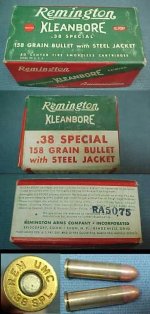naval_aviator
Member
- Joined
- Dec 9, 2013
- Messages
- 10
- Reaction score
- 5
Hi, I have a question—does anyone have a technical drawing of .38 Special 158 grain bullet with a steel jacket from 1940s? I'm looking to create a 3D print of this ammunition and need its exact dimensions, with the main challenge being measuring and preparing the bullet itself.
Thx,
Jerry
Thx,
Jerry

